If you've eaten Korean food, you know it's delicious.

Whether you've flipped sizzling beef over a Korean barbecue, crunched down on a tangy piece of kimchi, or basked in the warm steam wafting off a bibimbap bowl, the experience is captivating.
What you might not know, though, is that your meal likely came with a heaping side of government funds.
In 2009, the South Korean government launched the $40m Korean Cuisine to the World campaign with the goal of improving South Korea's global reputation through its food.
In the years to come, the government would spend millions of dollars opening Korean restaurants abroad, developing and standardizing recipes, and working to make South Korea a culinary destination for international tourists.
But can food really help elevate a country's reputation? And how much further can South Korea push its food campaigns?
Diplomacy on the menu
Gastrodiplomacy, a term first coined by The Economist in 2002, happens when governments try to increase the value and knowledge of their nation through food.
Though the term was born in the 21st century, the tactic can be traced back to the Greeks and Romans inviting their adversaries to the table to break bread, drink wine, and settle arguments.
Much later, President Richard Nixon's attempt at using chopsticks in China led to a rise in Peking duck on American menus, while a dessert served in a shoe during a meal between Israeli and Japanese prime ministers caused an uproar.
Food's universal importance makes culinary diplomacy effective everywhere in the world, wrote Sam Chapple-Sokol in The Hague Journal of Diplomacy. A government can rely on the friendlier aspects of its image to appeal to foreign governments and populations.
.jpeg?width=2000&height=1320&name=Nixon%20china%20(1).jpeg)
Nixon gives chopstick diplomacy a try in 1972. (National Archives)
Those friendlier aspects of a nation's culture can be a welcome reprieve from the usual, more forceful tactics countries use to gain power, such as military or political agendas.
"You don't reach people through rational information. You reach them through emotional, trans-rational connections that come through music, food, art, dance, and culture," Paul Rockower, a leading expert in gastrodiplomacy, told The Hustle.
Reaching people in this way is known as soft power, or a country's ability to accomplish its goals through positive attraction rather than through exerting force. Rather than coming directly from government actors, it's born from their collaboration with cultural sectors.
Thailand was the first country to launch a formal gastrodiplomacy plan with its 2002 Global Thai campaign.
The campaign hinged on making it as easy as possible to open Thai restaurants abroad: Templates were made for opening different types of restaurants, from fast-casual to high-end‚ and assistance was given with sourcing authentic Thai ingredients and obtaining visas for chefs.
When the program was launched, there were ~5k Thai restaurants globally. Today, there are more than 15k. Thailand also saw steady growth in foreign tourists over the years, peaking pre-pandemic with 40m visitors in 2019 who spent a collective $56.7B.
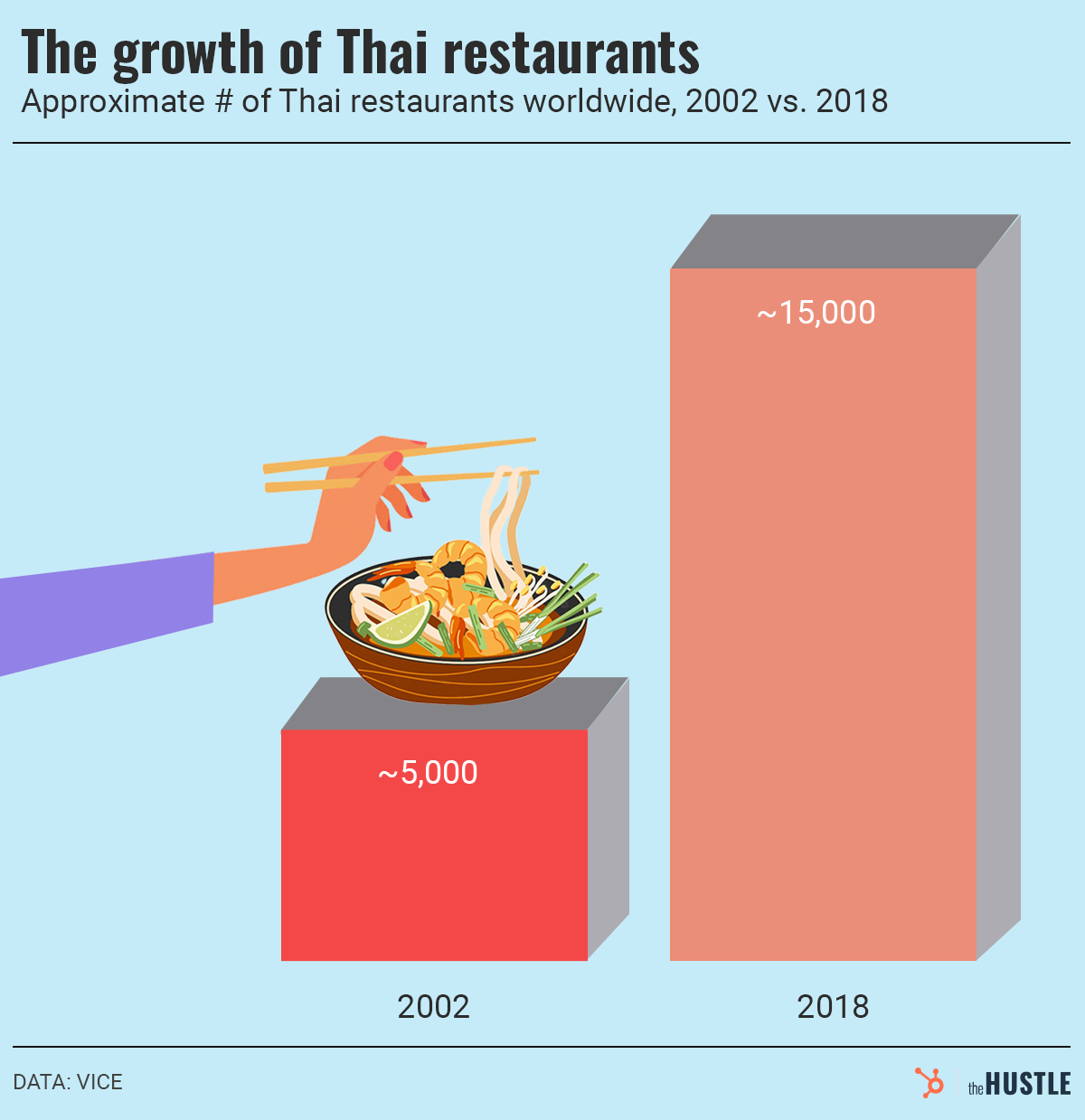
After seeing the success of Thailand's campaign, other countries followed suit: Japan, Malaysia, Taiwan, Peru, and the Philippines have launched official gastrodiplomacy efforts.
As did South Korea, which executed one of the most impactful gastrodiplomacy campaigns yet and ignited a cultural movement.
Kimchi meets the world
In the late 2000s, South Korea had a problem. Despite being home to international conglomerates like Hyundai and Samsung, and an acclaimed film scene, the general public didn't realize many of the country's leading cultural and business exports were Korean.
The Anholt-GfK Roper Nation Brands Index, an indicator of a country's popularity for investment and travel, ranked South Korea 33rd out of 50 countries.
The nation brand was being cannibalized by the Japanese brand, said Rockower.
Then-president Lee Myung-bak, a former CEO of Hyundai Engineering & Construction, was bothered by South Korea's lack of recognition. He set a goal to move up to 15th place on the index by 2013.
And Lee decided the quickest way to get there was through the world's stomachs.
He vowed to expand the country's international culinary footprint through a ~$40m campaign. Among his goals:
-
Increasing the number of overseas Korean restaurants from 10k in 2007 to 40k by 2017
-
Opening 100 top-tier Korean restaurants around the world by 2017
-
More than doubling agricultural and seafood exports, from $4.4B in 2008 to $10B by 2012
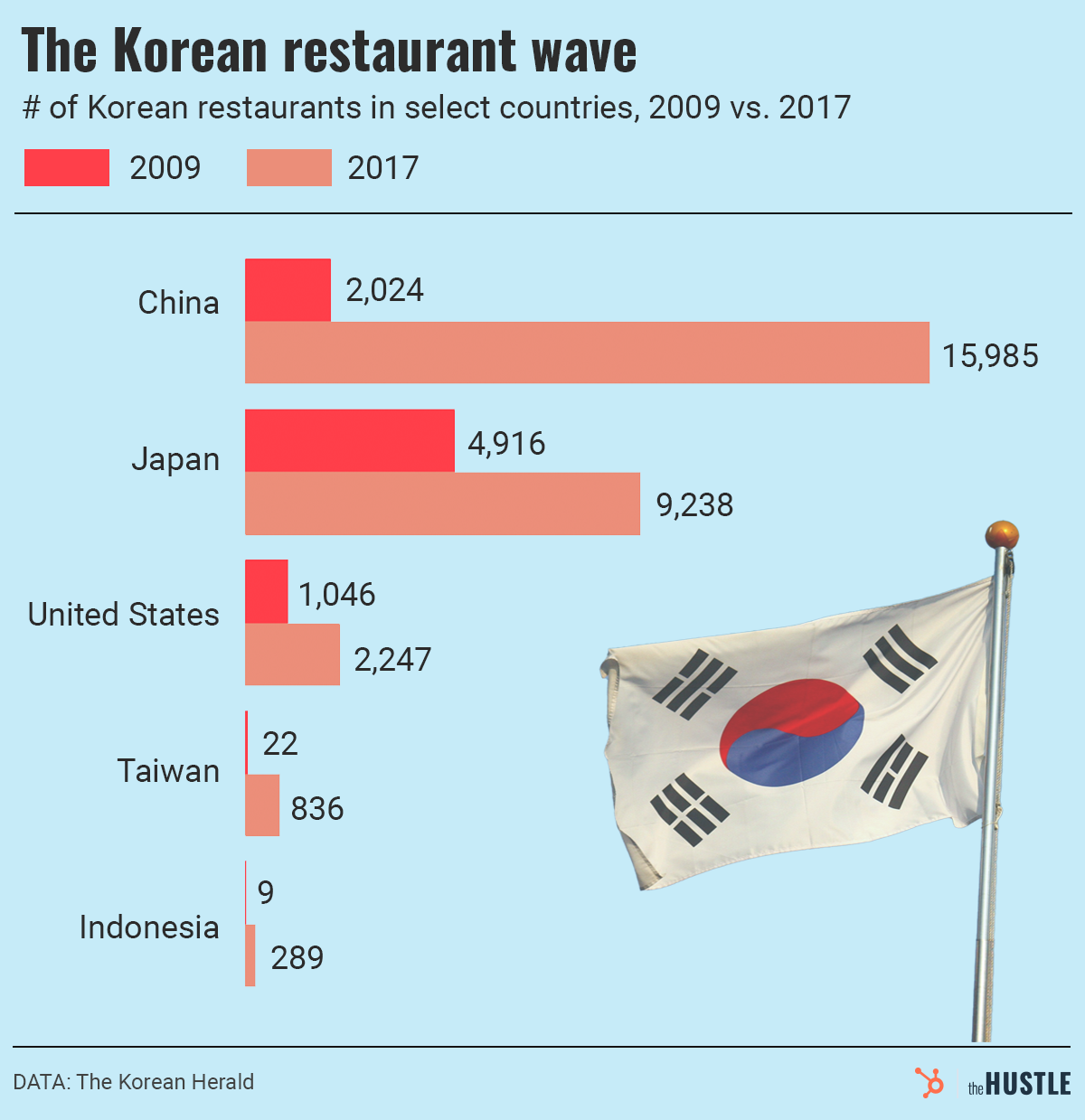
The campaign got to work immediately. In 2009, the country registered gochujang (red pepper paste), doenjang (soybean paste), and ginseng with the Codex Alimentarius Commission, an international organization that oversees food safety standards and guidelines that can elevate knowledge of listed foods. As of 2021, South Korea has established six Codex standards.
While Rockower says gastrodiplomacy is a long-term tactic that takes years to show results, rankings and lists can serve as short-term outcomes that prove the efficacy of a country's campaign. They can also help assert countries as foodie destinations in the eyes of tourists and the media.
And more projects followed:
-
First lady Kim Yoon-ok served Korean food to US Korean war veterans in 2009
-
Researchers investigated whether a Korean diet would be an effective weight-loss tool for Westerners in 2012 (it wasn't)
-
In 2013, Kimjang‚ the practice of making and sharing kimchi ‚ was added to UNESCO's list of Intangible Heritage
The country's officials realized one traditional dish could best elevate its brand: kimchi, a salted and fermented vegetable dish made most commonly with cabbage.
The government created the World Institute of Kimchi in 2009. The institute's mission was (and still is) simple: to drive the growth of the kimchi industry through technological development and to establish the status of South Korea as the mother country of Kimchi.
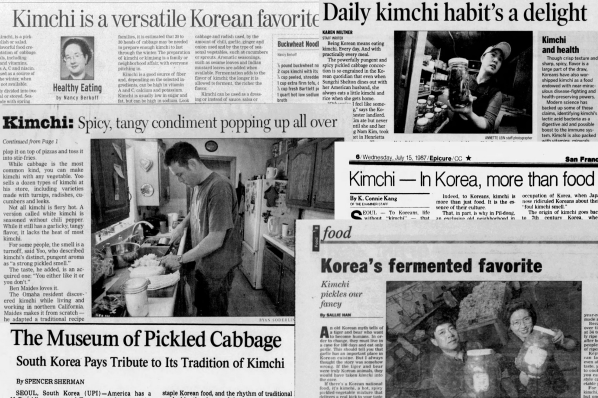
American media coverage of kimchi (via assorted newspaper clippings)
The campaign was boosted by giant South Korean companies and smaller grassroots efforts.
-
CJ Foodville, one of the largest food producers in South Korea, launched Bibigo, a fast-casual chain that also sells products in grocery stores and online. CJ Foodville's parent company now accounts for 40% of the US dumpling market and sold $508m of Bibigo dumplings around the world in 2020, $318.5m of which came from the US alone.
-
The Bibimbap Backpackers ‚ a group of five 20-somethings sponsored by the Korean government and CJ Foodville ‚ traveled to 15 countries over 255 days in 2011, cooking Korean food and teaching locals about Korean cuisine.
-
Similarly, the Kimchi Bus promoted Korean heritage through the craft of making kimchi in 34 countries around the world, covering 80k kilometers.
South Korea's campaign also coincided with important food trends unfolding in America.
Korean tacos topped with kimchi took off in 2008 when chef Roy Choi started his Korean taco truck, Kogi, in Los Angeles, home to the largest Korean population in the US. When the Kogi truck opened for business, it posted its location on Twitter and regularly drew lines of 300-800 people.
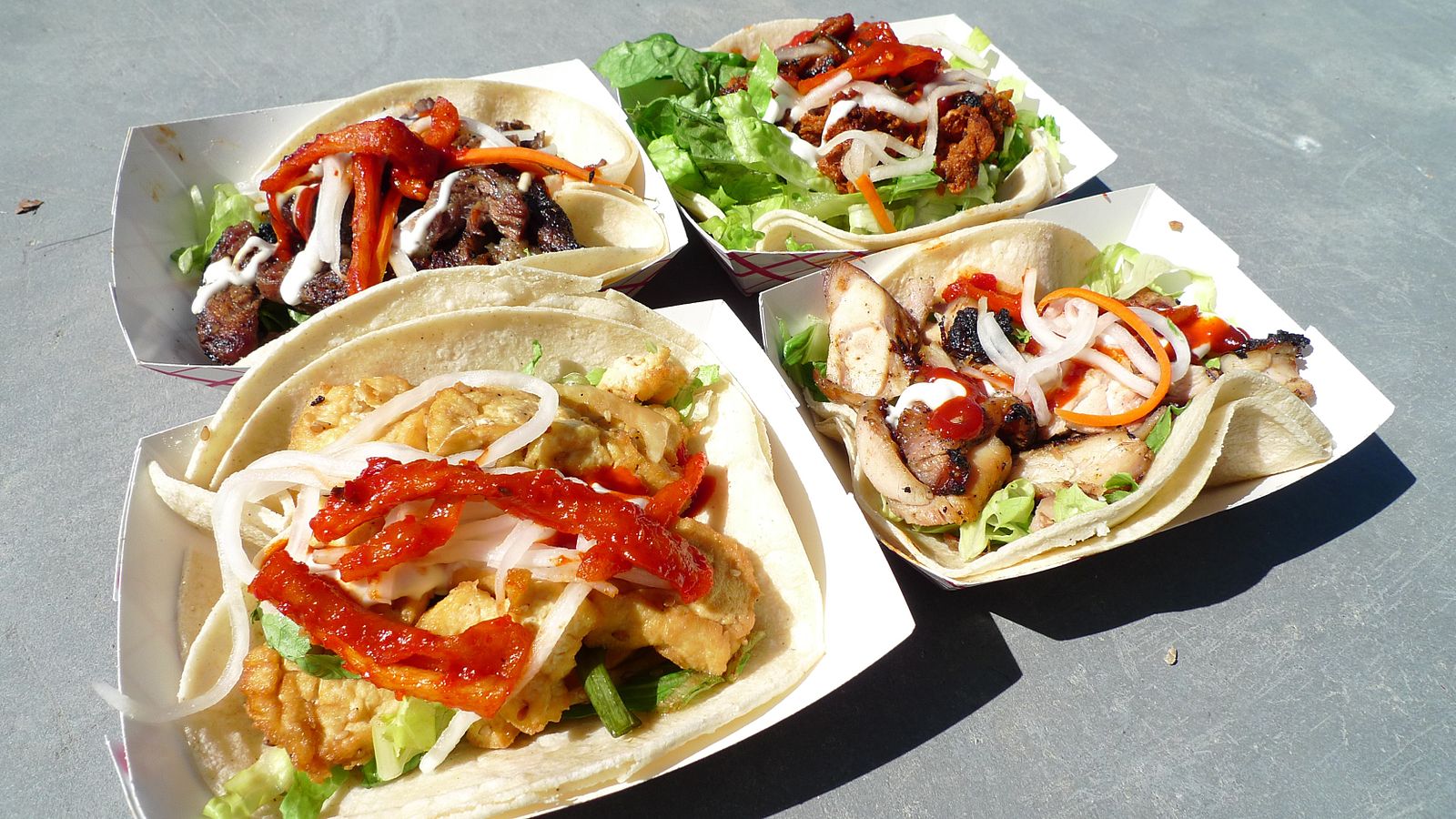
Korean tacos from a Bay Area food truck. (Arnold Gatilao via Wikimedia Commons)
Around the same time, interest in functional foods and gut microbiomes led even more people to try kimchi.
Driven in part by this proliferation of Korean products in the US, South Korea's kimchi exports reached a record high of $159.9m in 2021.
Surfing the Korean wave
While Korea's food campaign was powerful, the kimchi did not stand alone. With an uptick in South Korean food came a rise in South Korean culture abroad.
"That was the brilliance of South Korea's gastrodiplomacy campaign," says Rockower. "Suddenly you had Korean films, Korean music, Korean food, and the ubiquity of it helps create people who are more interested."
Korean trends and exports are increasingly part of the international pop culture landscape, including:
-
Korean beauty products (the market was valued at $8.3B in 2021)
-
Netflix's Squid Game (and the streaming service's $2.5B investment in a Korean studio)
-
The Oscar-winning film Parasite
-
Music, including K-pop (particularly popular are the groups BTS and Blackpink) and the 2012 hit song Gangnam Style
-
Mukbang, a social media trend where people eat on camera
An ultimate mashup of Korean culture and food occurred when musician Michelle Zauner's book Crying in H Mart became a mainstay on bestseller lists in 2021 and 2022. (H Mart, an American supermarket chain specializing in Korean food, now has ~100 locations in the US.) The book will be adapted for film by Orion Pictures.
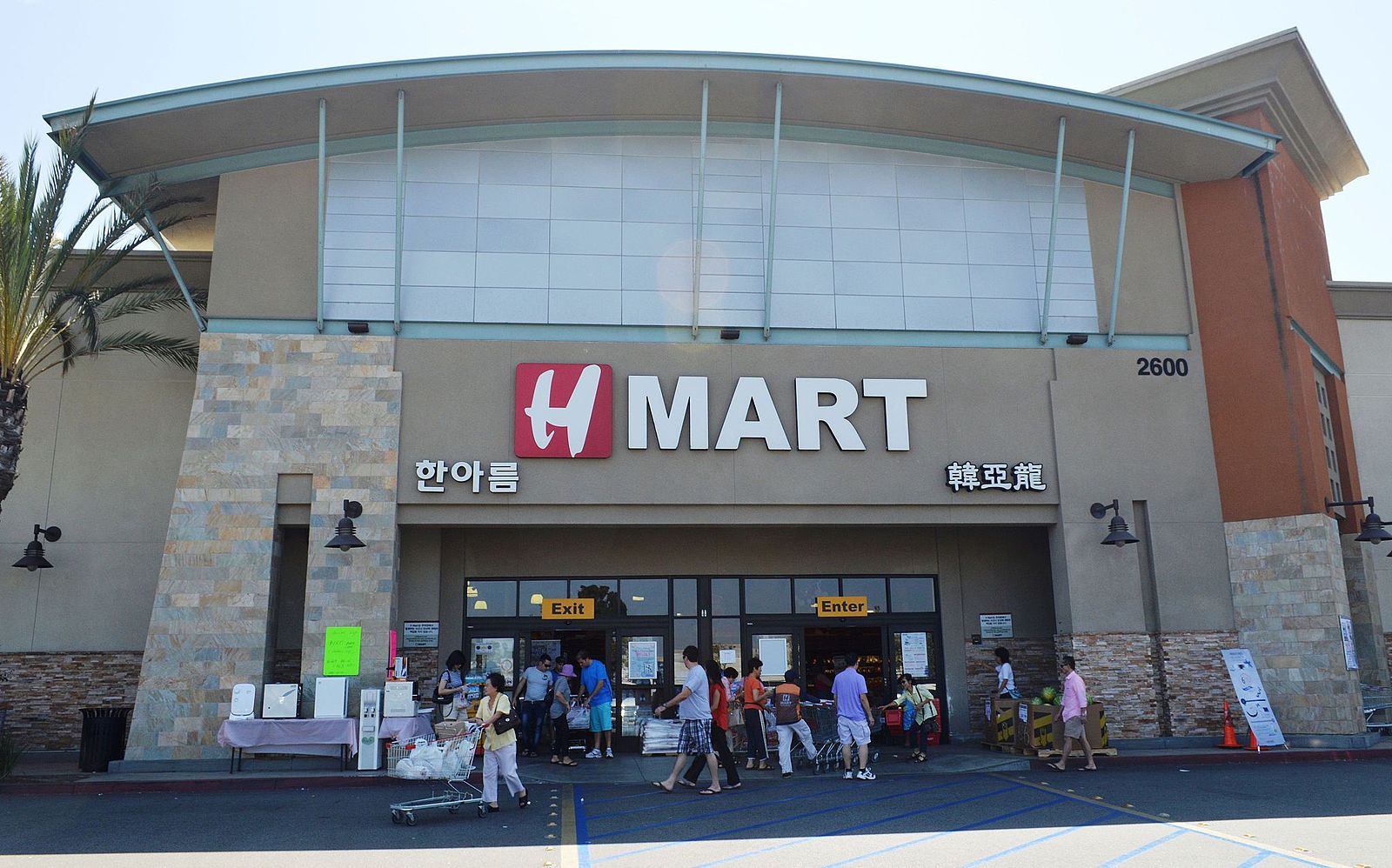
Shoppers enter an H Mart in Irvine, California. (Nandaro via Wikimedia Commons)
While none of these cultural trends can be traced directly back to the original Korean Cuisine to the World campaign, each serves a pivotal role in building the country's reputation and introducing its food to foreigners.
"Food has come to the forefront of contemporary popular culture: star chefs, social media, TV, movies," Fabio Parasecoli, a professor of nutrition and food studies at New York University, told The Hustle. "Gastrodiplomacy responds to a growing interest in food as a way to express cultural capital‚ to know the ins and outs of foreign cuisine is now a sign of culture and refinement."
Hungry for more
Fourteen years later, the success of South Korea's gastrodiplomacy is evident. Yet the country is still searching for something elusive: brand recognition.
In 2018, a poll from the Korean Food Promotion Institute indicated ~88% of US residents were satisfied with Korean food but only ~63% were aware of it. Meanwhile, the Anholt-Ipsos Nation Brands Index (what the Anholt-GfK Roper Nation Brands Index is now called) ranked South Korea 23rd last year, several spots from its goal of 15th.
.jpg?width=3861&height=2574&name=Banchan%20(1).jpg)
Korean banchan (side dishes) at a dinner table.
Last year, the Korean Food Promotion Institute noted Japan had branded its food as high-end, clean, and fancy, and Thailand had branded its cuisine as down-to-earth.
Korean cuisine, too, needs branding and an image for global prominence, says a report from the Korean Food Promotion Institute.
So, by the end of this year, the country intends to finalize a strategy to solidify its culinary brand. Consider it the next course of South Korea's gastrodiplomacy.
.jpg?width=48&height=48&name=IMG_2563%20(1).jpg)
